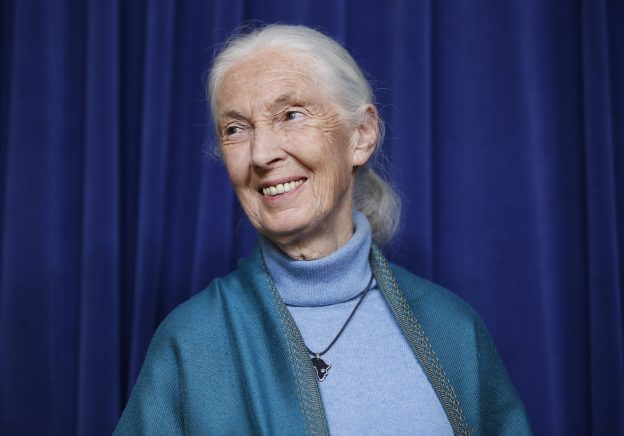
(RNS) — In a hall filled with robes and rituals, Jane Goodall was the only one without an institutional affiliation. Yet she was the one who spoke most like a spiritual guide. Others invoked Scripture; she invoked the natural world and described sunlight through rain forest leaves as stained glass, and the gaze shared with a chimpanzee as a holy encounter.
That was the summer of 2000, at the United Nations’ World Peace Summit of Religious and Spiritual Leaders. More than 1,500 dignitaries had gathered in New York: priests, bishops, rabbis, imams, shamans, yogis and even chiefs from the remote Queros people of Peru who had never before left their mountain village. My task was to interview delegates. Out of dozens of conversations, none was more memorable than my 90 minutes with Jane Goodall, the primatologist and anthropologist who died Oct. 1 at age 91.
By then, Goodall had already changed how humanity understood itself. As a young researcher in Africa, she had shown that chimpanzees used tools, organized societies and displayed emotions once thought exclusively human.
That revelation humbled our species, forcing us to see continuity between us and our fellow primates where we had imagined a wall. Later she broadened her mission, shifting from discovery to advocacy, fighting for habitats, for conservation, for the survival of the natural world itself. Soon after our meeting, then-United Nations Secretary-General Kofi Annan named her U.N. messenger of peace, a role she carried with quiet authority until her passing at age 91.
What struck me about Goodall that day was not her resumé but her way of speaking about spirit. When I asked whether she identified with a particular faith tradition, she smiled impishly and replied, “Is the forest not a cathedral? For me, it is, with its canopies of trees and beautiful lights.” For her, the sacred was not confined to ritual spaces; it was alive in root and branch, in the luminous weave of life itself.
I pressed further. “You lived closer to the chimpanzees than perhaps anyone in history. How was it different from living among people?”
“Not so different,” she said. “Staring into the eyes of a chimpanzee, I saw a thinking, reasoning personality looking back. You never really knew what their thoughts were, but you knew there was a real presence there, a consciousness. How should we treat them? Surely, with the same consideration and kindness we show humans. And if we recognize human rights, should we not also recognize the rights of the great apes? I think so.”
That was Jane Goodall’s genius: an eloquence that dissolved boundaries between science and spirit, between human and animal, between nature as backdrop and nature as sanctuary. In a summit crowded with religious authorities, she was the one who most vividly pointed us back to the ground beneath our feet and to all the beings who share it.
She reminded us that sacred is best defined not by doctrine but the living planet we call earth, and that the true test of faith is whether we can treat the earth and all its inhabitants, human and other-than-human, with the reverence they deserve.
(Joshua M. Greene is a filmmaker and the author of “Golden Avatar,” a forthcoming biography of Chaitanya, a pioneer of universal rights in 16th-century India. The views expressed in this commentary do not necessarily reflect those of Religion News Service.)
